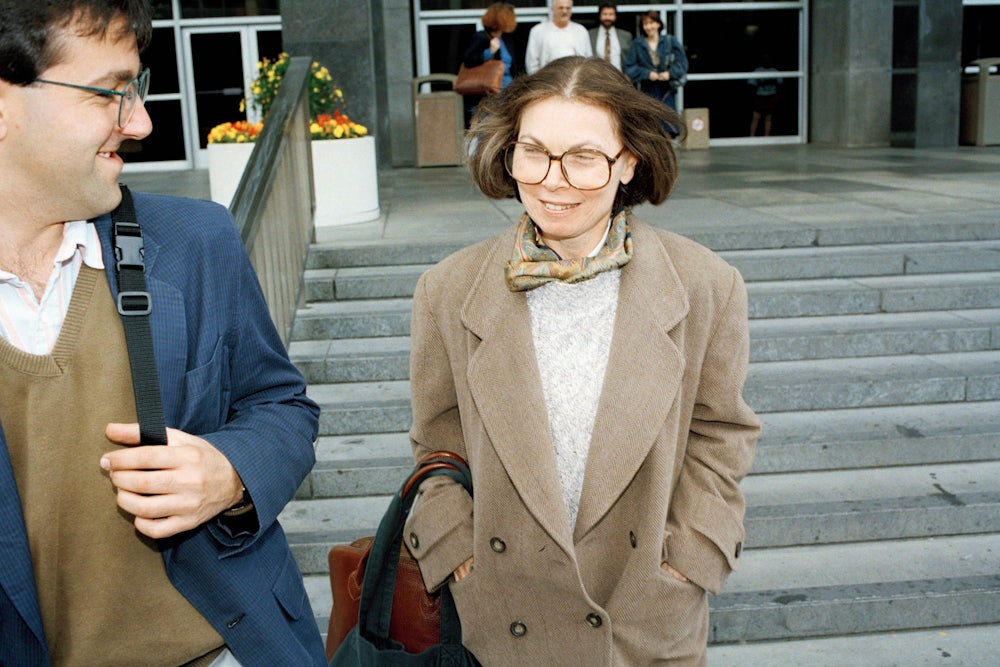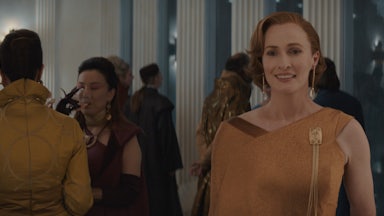I started reading Janet Malcolm the year I came to the United States. Encountering her work felt like emerging from ignorance—revelatory and more than a bit humbling. At 23, I was embarrassed not to have heard of her before. If the most quoted parts of The Journalist and the Murderer sounded dimly familiar, it was only in the same way anything well put feels recognizable. Pre-Malcolm, I was like one of the subjects of her stories, fatally lacking in self-awareness and quick to judgment, despite continually revealing how little they know or want to know about anything.
I have been thinking since then about the country that Janet Malcolm, who died yesterday at 86 years old, described. It was not quite the place I had moved to; it was, on the surface, much more appealing. The people in her stories are “pleasant-looking” and dress neatly. They live in carefully arranged, strangely revealing homes; their offices are rarely more ostentatious. They eat unpretentious food. She shows a cautious appreciation of the plain and unassuming throughout her work, and in a distinctly American style, as early as her 1963 poem “Thoughts on Living in a Shaker House,” which opens: “This Shaker house is neat and low / and everything is made just so.” It makes glorious sense that 50 years later, she would scrutinize the beigest of the beige in her celebrated profile of Eileen Fisher.
This is a wholesome kind of America, with some of the “grudging elegance,” as the poem has it, and solidity of the postwar years. It’s almost soothing to enter into the world of a Malcolm book or profile, and start to meet the well-tended, unfussy characters: The Artforum editor, Ingrid Sischy, a woman “with cropped dark wavy hair,” wears “the plainest of clothes”; the artist Sherrie Levine in the same multipart piece is a “pleasant, unmannered woman,” also with “dark wavy hair.” In The Journalist and the Murderer, an intransigent juror, Lucille Dillon, is “pleasant-looking,” too—a “self-possessed woman of sixty” wearing “white slacks, a white overblouse, and white sneakers.” There are beautiful Malcolm touches in the apparent simplicity of these women’s styling. What could be more simply beguiling than the spread of “bread and cheese and Granny Smith apples” that Malcolm notes on Levine’s table? Or the “room-service lunch of avocado salad and sherbet” that she shares with Dillon—not just a meal but a window into a specific world at a specific moment (take me there!), its modest delicacies.
The lunch with Dillon is a brilliant scene, because in the same mouthful as the avocado salad, the juror tells Malcolm about “her experiences at the trial.” And there is the characteristic sting in the tail, because this woman, despite the pristine quality of her dress, is clearly trouble. She has been the cause of a mistrial, which is why Malcolm has tracked her down to find out what she was thinking. The other jurors, we’re told, could not get her to deliberate with them once she’d made up her mind. She’s open with Malcolm about her reasons for believing the defendant was innocent: She just had a feeling he was. When Malcolm pushes a little further, the juror professes her belief in the Constitution and her dismay that “there are many unconstitutional things the government does.” Such as? “I’m thinking of the income tax,” she says.
Here we are with this perfectly ordinary woman, and at the same time, we have gone totally through the looking glass. Malcolm, of course, doesn’t belabor this. As Alice Gregory wrote in a retrospective of Malcolm for Slate, politics rarely entered into her writing. The figure that wields something like political power in her stories is not the voter but the juror—who enacts a more intimate form of participation. In The Journalist and the Murderer, the other jurors she spoke to proved just as incapable of making a reasoned assessment of the defendant as Dillon was. They believe he is guilty because “all of them ‘felt’ that McGinniss was not telling the truth.”
This is the way most people are in her stories. They look ordinary—but beneath the surface they are inchoate bundles of barely examined intuitions and wild certainties. And that, it turns out, is the most ordinary thing of all. The daughter of a psychoanalyst and the author of two books that take analysis as their setting—Psychoanalysis: The Impossible Profession and In The Freud Archives—Malcolm nonetheless claimed that psychoanalysis “had curiously little influence on my writing.” Yet in her encounters with the subjects of her stories, the unconscious is rearing up all the time. Scrape the surface of any these people, and you are quickly in the realm of the irrational.
Her books and reporting—from The Journalist and the Murderer to her recent essay “A Second Chance”—show a fascination with the unbending forms through which justice is administered and the confused, helpless, intransigent people who actually pass judgment on one another. It may be for this reason that, in the genre of true crime, she is the rare writer who did not go in for gore. At stake in The Journalist and the Murderer is the standing of the titular journalist, Joe McGinniss, assigned to write about the accused. The Crime of Sheila McGough similarly avoids flashiness, as Malcolm tries to untangle what happened to a small-town lawyer who, in defending a client from fraud, ended up going to jail herself; insofar as it’s a white-collar crime, it’s not the kind of big-ticket corporate wrongdoing that usually attracts attention. Her 2011 book Iphigenia in Forest Hills treated a murder, but Malcolm followed it with a three-part report in The New York Review of Books on a custody battle over the child of the murdered man, going deep into family court proceedings. It’s a paper trail rather than a body that proves mystifying. The case itself doesn’t need to be particularly interesting; the people involved always are.
Malcolm comes back to the idea, again and again, that a courtroom is a bad place to find out anything like the truth. So is the court of public opinion—as her depiction of feuding art world intellectuals showed. She has a unique talent for drawing out contradictions and making incoherence visible, invariably in taut, understated sentences. The world is a mess; the prose is, somehow, a windowpane. It may be that tension between chaos and the orderliness of description that makes the writing seem so revealing. The way people really are, the reasons for their decisions, you come away feeling, are areas that previous writers have hardly managed to touch. From the shambles of conflict, the supremely astute “I” of Malcolm’s writing emerges. There is something gripping about being guided by her, basking in what Gregory called Malcolm’s “terrifying neutrality.”
Is it wrong to probe so deeply into a person’s inner life, especially when they are in the grip of a crisis? Malcolm thought so, or so she wrote, in the now-famous opening lines of The Journalist and the Murderer: “Every journalist who is not too stupid or too full of himself to notice what is going on knows that what he does is morally indefensible … preying on people’s vanity, ignorance, or loneliness, gaining their trust and betraying them without remorse.” Even many years later, after those sentences had given her no end of trouble, she stuck to the position. In an interview with Katie Roiphe, she elaborated: “Trials offer exceptional opportunities for the exercise of journalistic heartlessness.”
Yet I often wonder if Malcolm overstated her own steeliness. So many writers venture out into the shaky territory of ambiguity that she lived in; for most, spending too long there can be a form of evasion, a way of not saying anything. What made Malcolm’s ambiguities so much more brilliant than those others’? Critics have emphasized a confrontational streak in her approach, often attaching phrases like merciless attention or pitiless scrutiny to her style—in the interview, Roiphe invokes a “dazzling sharpness”—to convey the precision of Malcolm’s writing, its mysterious ability to get to the point.
I see the sharpness, but I have never read it as mean or unfair. The merciless attention she pays her subjects may be uncomfortable, but the quality of really seeing a person seems to me to offer a sort of redemption. Pitiless it may be, but often tinged with wry humor too. The Crime of Sheila McGough opens, for instance, with this reflection: “It seems scarcely possible that in this country someone could go to prison for merely being irritating, but as far as I can make out, this is indeed what happened to Sheila McGough.” The thought is both shocking and oddly appealing. It’s hardly a defense of someone to call her “irritating.” But in a system that’s often cruelly impersonal, at least character counts for something—even if it counts against you. In her reporting on trials, Malcolm wrote about people embroiled in senseless, numbing litigation; sometimes it seems that as she pored over the transcripts, she may have been the only person attempting in earnest to untangle it.
This, for me, is the spell of her books: their quality of deliberation, their promise that all the little details of experience—the avocado salad and the sherbet and the Granny Smith apples—do in fact add up to something. That kind of attention is in short supply. What strikes me when I reread these books now is not the sheen of postwar calm, but the tensions it concealed. Just as smoothly as Malcolm evoked the ordinariness on the surface, she identified a particularly American unconscious. It’s the erratic impulses of her subjects—their tendency to blurt out whatever they are thinking, regardless of how bizarre or uninformed they sound—that make you say, how right she was.








